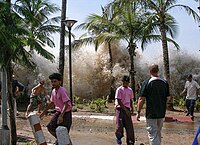
Photo from wikipedia
Abstract Landslide tsunami generation is a complex physical process that involves solid materials interacting with water bodies and other 3D nonlinear wave effects. Modeling of this process ranks as an… Click to show full abstract
Abstract Landslide tsunami generation is a complex physical process that involves solid materials interacting with water bodies and other 3D nonlinear wave effects. Modeling of this process ranks as an urgent task because wave source features are crucial clues for subsequent tsunami motions and hazards threatening coastlines. Herein, we introduce a concept of ‘Push Ahead’ (PA) in landslide/water interactions and propose a PA formulation integrated in a meshless numerical procedure named ‘Tsunami Squares’ (TS) for modeling of landslide tsunami generation. We draw comparisons on the physical significances of PA acceleration versus ‘Drag Along’ (DA) acceleration and conventional aerodynamic and hydrodynamic solutions. We carry out physical experiments of wave generation by block-dragging and gravel flows and corresponding TS simulations to study PA effects in landslide/water interactions. Wave features in TS simulations match the experimental observations in a reasonable range, providing a firm validation of the PA formulation in the TS approach. Sensitivity analysis that compares simulations with various ratios of PA acceleration is carried out both for the block-dragging and gravel flow experiments. The comparisons indicate that PA acceleration plays an important role in landslide wave generation and that larger PA accelerations make greater contributions to the initial wave source. We discuss intrinsic relations between PA formulation and the empirical equations derived from previous experiment studies that support the validity and applicability of the PA solution. We also insist that the complex 3D wave effects such as dispersion, shoaling, refraction, reflection and superposition, occurring in the experiments can be well reproduced in the TS simulations. The newly proposed PA acceleration that works together with our previously presented ‘Drag Along’ and ‘Lift Up’ effects can excellently illustrate the mechanical process of landslide water interactions. We conclude that TS simulations that do not include the ‘Push Ahead’ acceleration can seriously underestimate landslide tsunami size.
Journal Title: Engineering Geology
Year Published: 2021
Link to full text (if available)
Share on Social Media: Sign Up to like & get
recommendations!